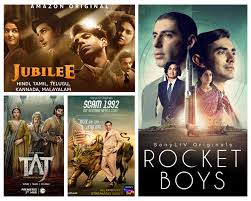Discover the captivating journey of Indian thrillers from the cinematic Golden Age to the modern era of OTT platforms. Explore the evolution, key milestones, and future of this genre in Indian entertainment.
Indian thrillers have been an integral part of the country’s cinematic and storytelling heritage. Over decades, the genre has transformed, blending classic suspense with cutting-edge technology and contemporary themes. From noir-inspired films in the Golden Age of Indian cinema to the digital revolution driven by OTT platforms, the evolution of Indian thrillers reflects the changing tastes and sensibilities of its audience.
In this article, we delve into the fascinating transformation of Indian thrillers, exploring their journey through different eras, their adaptation to new mediums, and the trends shaping their future.
The Golden Age: The Birth of Indian Thrillers
The Post-Independence Era (1940s-1960s)
The Golden Age of Indian cinema, spanning the 1940s to 1960s, saw the emergence of thrillers that were inspired by Hollywood noir and detective genres. Films during this era often depicted morally complex characters, shadowy settings, and intense narratives.
Key Highlights:
- Iconic Films:
- Baazi (1951) by Guru Dutt introduced elements of suspense and gambling.
- C.I.D. (1956) brought detective stories to the mainstream.
- Influence of Literature: Many thrillers drew inspiration from Indian crime novels and pulp fiction, blending literary depth with visual storytelling.
- Actors Who Shone: Stars like Dev Anand became synonymous with suave and mysterious protagonists.
These films were characterized by melodramatic storytelling, yet they laid the foundation for thrillers as a distinct genre in Indian cinema.
The Transition Era: Experimentation and Expansion
The 1970s-1990s
The next few decades saw Indian thrillers diversify into sub-genres, including psychological thrillers, action-packed narratives, and courtroom dramas. This period marked the shift from traditional noir influences to themes that resonated with contemporary social issues and personal conflicts.
Key Developments:
- Rise of Psychological Thrillers: Films like Kanoon (1960) and Ittefaq (1969) focused on human emotions and suspense without relying on musical sequences.
- Action and Spy Thrillers: The 1970s and 1980s introduced spy thrillers like Agent Vinod (1977) and gritty action films such as Don (1978), blending suspense with high-octane drama.
- Influence of Technology: Enhanced cinematography and sound design allowed filmmakers to create gripping atmospheres and intricate plots.
By the 1990s, thrillers began embracing globalization, drawing inspiration from international films while retaining an Indian essence.
The Digital Era: Thrillers on OTT Platforms
2000s to Present
The advent of digital streaming platforms has revolutionized how Indian thrillers are created, distributed, and consumed. OTT platforms like Netflix, Amazon Prime Video, and Hotstar have provided filmmakers with creative freedom to explore bold themes, complex characters, and unconventional storytelling formats.
Characteristics of Modern Thrillers:
- Genre-Bending: Thrillers today often merge with other genres, such as horror (Tumbbad), comedy (Andhadhun), or crime dramas (Sacred Games).
- Global Appeal: With international viewership, Indian thrillers now incorporate universal themes and slick production values.
- Binge-Worthy Series: Serialized storytelling, as seen in Delhi Crime and Paatal Lok, allows for deeper character exploration and intricate plots.
- Focus on Realism: Modern thrillers often depict realistic scenarios, addressing issues like corruption, gender violence, and social inequality.
Notable Thrillers on OTT:
- Sacred Games (Netflix): A groundbreaking crime thriller that combines philosophy and action.
- Family Man (Amazon Prime): A spy thriller blending humor and action with contemporary geopolitical themes.
- Drishyam 2 (Amazon Prime): A masterful sequel to the hit film, showcasing clever storytelling.
Key Trends Shaping the Future of Indian Thrillers
1. Rise of Regional Content
Regional thrillers are gaining popularity, with films from Tamil, Telugu, and Malayalam industries setting benchmarks for storytelling and innovation (Super Deluxe, Kumbalangi Nights).
2. Technology and Innovation
Advanced visual effects, AI-driven scripts, and immersive soundscapes are enhancing the cinematic experience for thriller enthusiasts.

3. Global Collaborations
Indian filmmakers are increasingly collaborating with international studios, bringing fresh perspectives and expanding the reach of Indian thrillers.
The journey of Indian thrillers, from the Golden Age of cinema to the dominance of OTT platforms, highlights the genre’s adaptability and timeless appeal. By embracing innovation and staying rooted in compelling storytelling, Indian thrillers continue to captivate audiences both domestically and globally.
As digital platforms evolve and new technologies emerge, the future of Indian thrillers promises even greater excitement, diversity, and creative possibilities. Whether it’s a suspenseful whodunit, an intense psychological drama, or a gripping crime saga, Indian thrillers are poised to remain a significant part of the entertainment landscape.
FAQ
What are some must-watch Indian thrillers?
Some must-watch Indian thrillers include Andhadhun, Drishyam, Kahaani, Sacred Games, and Tumbbad.
How have OTT platforms impacted Indian thrillers?
OTT platforms have given filmmakers the freedom to explore bold themes, develop nuanced characters, and reach a global audience without the constraints of traditional cinema.
Why are regional thrillers gaining popularity?
Regional thrillers offer unique storytelling styles and authentic cultural perspectives, appealing to diverse audiences and showcasing India’s rich linguistic and cinematic diversity.
What sets modern Indian thrillers apart from older ones?
Modern thrillers often focus on realism, innovative storytelling, and high production values, catering to a more discerning and global audience.
Are Indian thrillers gaining global recognition?
Yes, Indian thrillers like Delhi Crime and Sacred Games have received critical acclaim worldwide, showcasing the genre’s potential on an international stage.